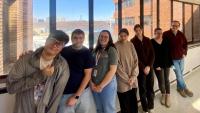April 2023: Alex Dranovsky Lab

Background:
What is the main focus of your lab?
We are interested in understanding how stressful experiences change brain functions and why some developmental periods are particularly sensitive to stress.
How long have you had your lab? When did you join Columbia University?
I arrived at Columbia for clinical training in Psychiatry in 2000. I did my internship in medicine and psychiatry residency and then a research fellowship in schizophrenia. I stayed on as faculty after that.
How big is your lab currently?
We are currently around 10 people between postdocs, graduate and undergraduate students and a research technician
Where is your lab located?
Kolb Annex of the New York State Psychiatric Institute (Kolb 1)
Current affairs:
What are the most exciting projects/directions in the lab at this moment?
We are examining the role of non-neuronal cells in mediating the effects of early life adversity on memory circuits. We are also testing a hypothesis that neuronal functions in the hippocampus are dictated by the birthdate of the neuron.
What are the biggest accomplishments that your lab recently had?
Most recently we have found that hippocampal stem cells and their neural progeny are essential to mainaining hippocampal inputs and functions. In the absence of adult neurogenesis we observed major reorganization of select hippocampal inputs. We have also collaborated with a non-human primate lab to successfully implement the use of genetically encoded biosensors during behavior.
Technology:
What are the model systems that your lab is using?
We combine transgenic lines (mostly available from JAXMice) with neurotropic and gliatropic viruses to target and manipulate stem cells and selective neuronal circuits mostly im mice. At times we take our questions into tissue culture.
What are the key techniques that your lab is using? Are you open to training scientists from other labs?
We use the genetic targeting to enable selective pharmaco- and opto-genetic manipulations and behavior. We also use fiber photometry with genetically encoded biosensors in awake behaving animals. We also perform a fair bit of circuit analysis in both opaque and cleared delipidated tissue with the aid of viral anterograde and retrograde direct and trans-synaptic tracers. We combine these techniques with computational and AI approaches for analysis of behavioroal and microscopy data. We are always happy to collaborate.
What facilities or equipment does your lab absolutely rely upon? Do you use CSCI cores?
We do a lot of confocal imaging and also signal capture in awake behaving animals. We have occasionally used the Imaging core and FACS cores. A light sheet microscope would be a wonderful addition to the imaging core.
Who shall be contacted with questions about equipment, resources and training?
Imaging – Jacob Nye. Behavior – Maria Bompolaki.
Training:
What's your best approach to mentoring trainees in the lab?
I try hard to adjust mentoring approach to the strengths of the trainee. Some do better with a lot of guidance and hand-holding while others do better when they are given more independence.
Who were your most influential mentors/role models in science and what did you learn from them?
In addition to my regular mentors I was heavily influenced in scientific approached by Carleton Gajdusek and Judah Folkman.
What would be your career advice for students/postdocs?
It's a tough and long road. Make sure that you love what you do and always ask yourself “Whats the question?” I still do this routinely.
Are you accepting rotating students at the moment?
Yes
Lab management:
How do members of your lab celebrate accomplishments?
Eating and drinking
Does your lab have any fun traditions?
I like to get everyone together for a barbecue in the summer though COVID did get in the way of that.
What is the key to running a successful lab?
Surround yourself with strong people and then listen to what they have to say.
What was the most exciting part about starting your new lab?
Building a team.
CSCI:
What was the main reason of you joining CSCI? What are the beneficial aspects of CSCI membership for your lab?
Interacting with members of the community who are working in other organ and experimental systems.
What do you plan to bring to the CSCI community?
I like collaborating with scientists who have different interests. It ensures fresh perspectives on old questions.